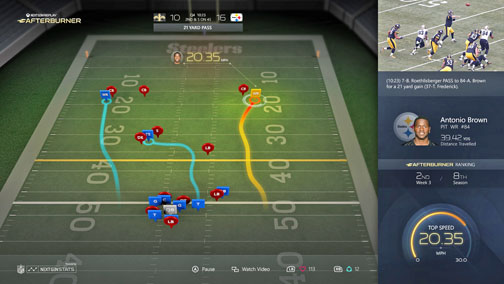The National Football League is doing some interesting high-tech these days. All of their 1,696 players have a pair of RFID sensors, which are roughly the size of a quarter, installed in their shoulder pads. The sensors register movement, distance, and speed, and this data is then compiled into a comprehensive database of game information. It can generate real-time broadcast overlays of all the action on the field and real-time visualizations for coaching staffs.
The league first started implementing this during the 2014 season, and now the system is in all stadiums. The entire hardware and software system is supplied by Zebra Technologies. Zebra provides this same “asset intelligence” to customers in the retail, manufacturing, transportation, and healthcare industries, helping them make more informed business decisions.
The stadiums are outfitted with cigar-box-sized receivers across the venue to triangulate the players' movements. The devices can track the players from up to 1,000 feet away. At Levi's Stadium in Santa Clara there are 20 of these receivers and players and the field officials are tracked at least 15 times a second. The system operating frequency is 6.35 to 6.75 GHz and it yields an accuracy of ±1 foot without averaging, and ±4 inches with averaging. There is also a Zebra Sports Solutions Server that the hubs attach to.
For the RFIDs, durability and battery life were certainly concerns. Zebra houses them in a piece of plastic that is super durable. They can take a hit on the field and they are able to be washed and dried with the jersey after the game. The tags’ batteries last the full season.

It is a bit worrisome. Maybe it will encourage other employers to track their employees every move. Maybe all of us will be wearing sensors in our shoulder pads one day.
Fig. 1: Xbox One, now with next gen stats.
The NFL also uses the data generated to power the NFL 2015 app for Xbox One and Windows 10, allowing fans to call up stats for each player tied into highlight clips posted on the app. The data is also fed to broadcasters and leveraged for in-stadium displays.
In real-time, the teams can tell when a player is not working as hard as usual, not running as fast as usual, not hitting as hard as usual. All this seem intrusive to me, but if you’re making $1.9 M a year (that’s the average), I guess you go with it.
Advertisement
Learn more about Electronic Products Magazine





